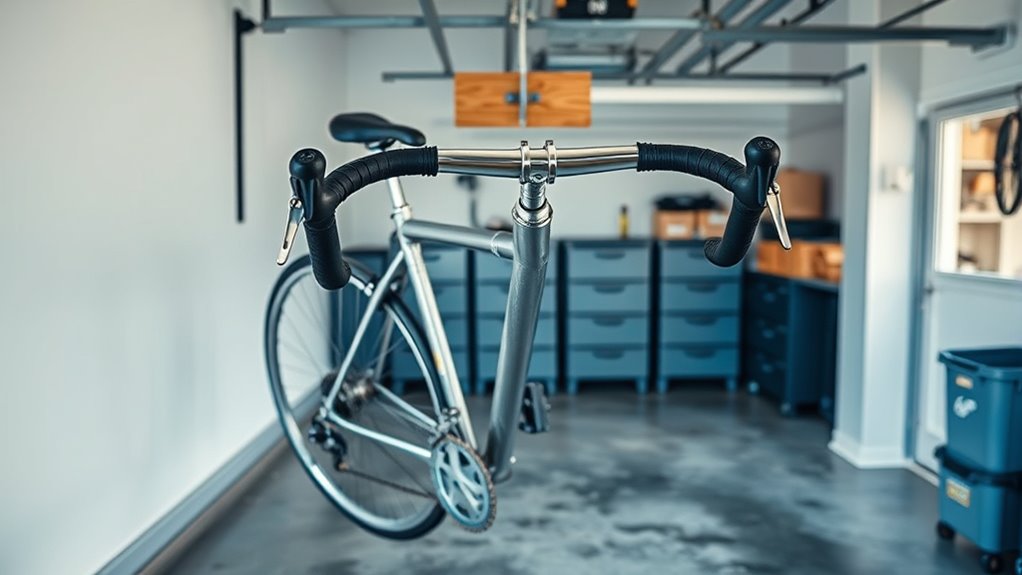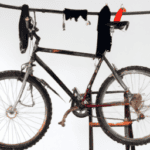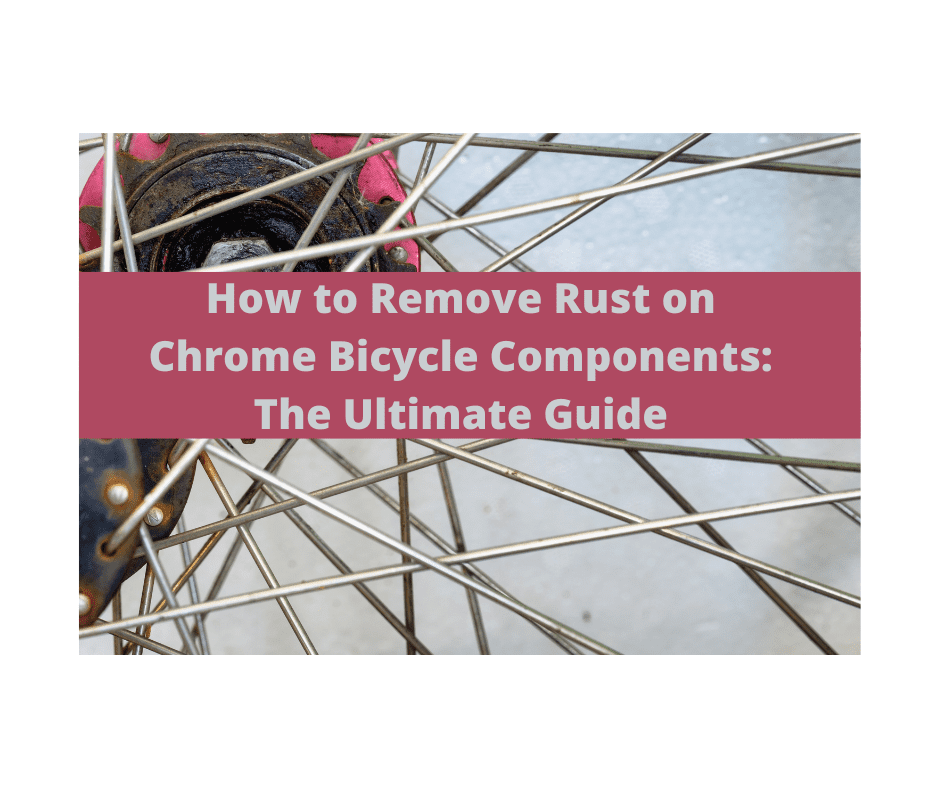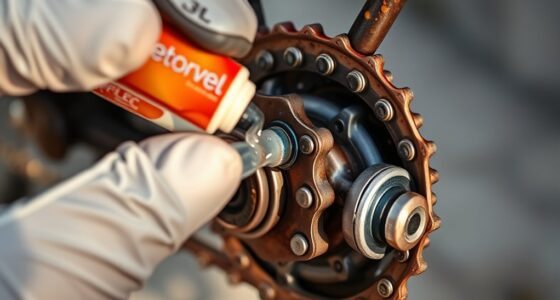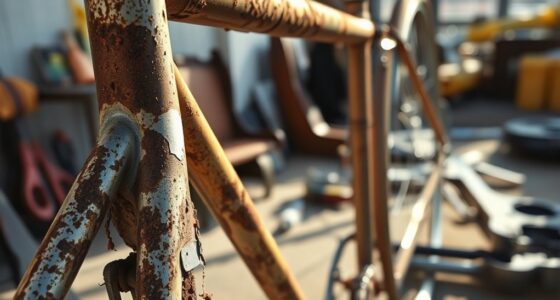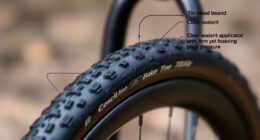To minimize rust, store your bike in a dry, well-ventilated space like a shed or garage, keeping humidity below 50%. Use a waterproof, breathable cover secured tightly and add ventilation holes to reduce condensation. Clean and dry your bike thoroughly before storage, then apply rust inhibitors or lubricants to metal parts. Regularly inspect and maintain the environment to prevent moisture buildup. Keep exploring for more tips to protect your bike long-term.
Key Takeaways
- Store the bike in a dry, well-ventilated indoor space away from moisture sources.
- Cover the bike with a waterproof, breathable cover secured tightly to prevent dust and water ingress.
- Clean, dry, and lubricate the bike thoroughly before storage to create a protective barrier against rust.
- Use moisture-absorbing materials like silica gel packs and ensure proper airflow to control humidity levels.
- Regularly inspect and maintain the bike and storage environment to address any signs of moisture or corrosion promptly.
Choosing the Ideal Storage Location

Choosing the right storage location is essential to keep your bike in top condition. You want a dry, ventilated space like a shed or garage that minimizes exposure to moisture and humidity, which can cause rust on exposed metal parts. An enclosed storage area shields your bike from rain, snow, and direct sunlight, preventing corrosion and material degradation. Keep your bike away from sprinklers, pooling water, and outdoor elements to reduce water contact and environmental contaminants. Elevating your bike on a stand or hooks prevents it from touching wet surfaces, further reducing rust risks. Ensure the area has good airflow and stays free from excessive dust and dirt, as dust can attract moisture. Proper storage helps preserve your bike’s condition and prolongs its lifespan. Additionally, avoiding exposure to humidity is crucial, as moisture accelerates rust formation on metal components.
Using Protective Covers Effectively
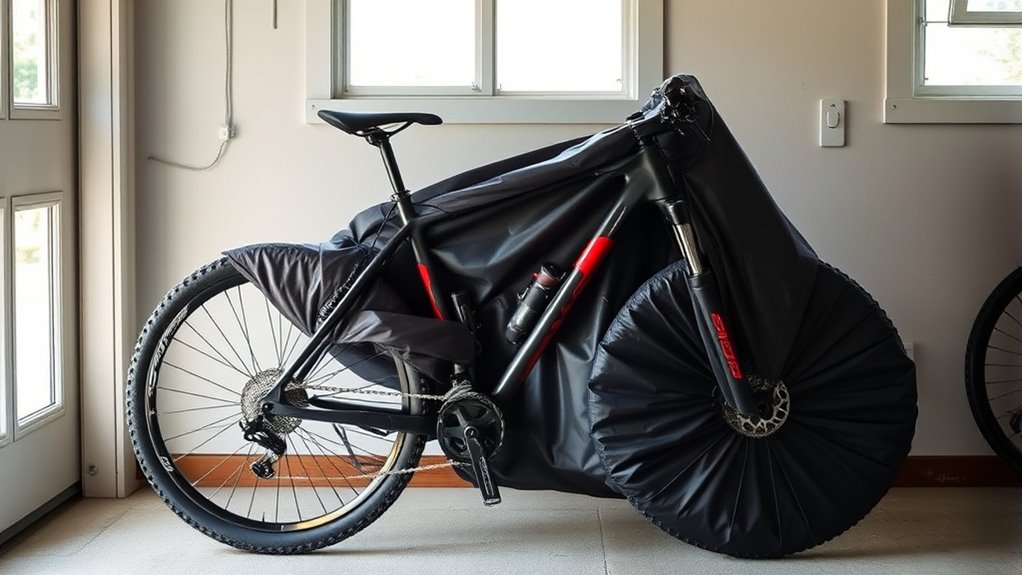
To keep your bike protected from the elements, using a waterproof yet breathable cover is essential. A high-quality cover helps prevent moisture from settling on metal surfaces, reducing the risk of rust. Choose one with reinforced grommets and UV resistance to withstand weather and sunlight. Make sure it fits snugly over the entire bike, including wheels and frame, to shield against dust, wind, and rain. Secure the cover tightly using bungee cords, zip ties, or weights to prevent it from blowing off. Small ventilation holes allow airflow, which helps reduce condensation and internal moisture that can cause rust. Proper use of covers is key to prolonging your bike’s life. Incorporating natural materials and ensuring good ventilation can further help prevent rust formation by allowing moisture to escape rather than become trapped inside the cover. Regularly inspect and clean the cover for dirt or tears, replacing or repairing as needed to maintain effective protection. Additionally, storing your bike in a sheltered environment when possible can significantly reduce exposure to harsh weather conditions that accelerate rust development. Ensuring proper air circulation around the stored bike can also play a vital role in minimizing moisture buildup and corrosion. Using a dehumidifier in enclosed storage spaces can further reduce ambient humidity and protect your bike from rust. Maintaining proper ventilation is especially crucial when storing bikes in enclosed spaces to prevent dampness from accumulating.
Properly Preparing Your Bike Before Storage
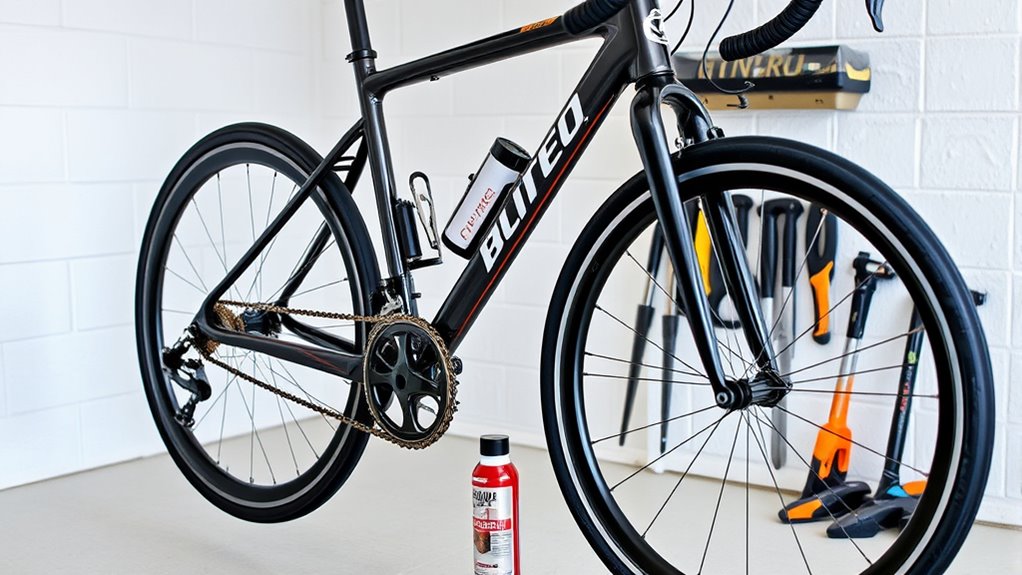
Before storing your bike, it’s essential to give it a thorough cleaning to remove dirt, sweat, and contaminants that can cause corrosion over time. Use mild soap and water to clean all surfaces, paying close attention to hidden areas like chains and inside frame tubes. Dry the bike completely to prevent residual moisture. Apply a water-displacing product such as WD-40 or a rust inhibitor to all metal parts, avoiding brake discs and rims. Lubricate moving parts like the chain, derailleur, and brake cables with appropriate lubricants to prevent rust. Tighten all bolts, screws, and fittings to ensure everything is secure. Proper preparation helps protect your bike’s metal parts during storage and minimizes the risk of rust formation. Incorporating advanced corrosion prevention techniques can further enhance the longevity of your bicycle during periods of inactivity, especially by utilizing proper storage conditions that control humidity and temperature. Additionally, using air purifiers with HEPA filters in your storage area can help reduce airborne pollutants that contribute to corrosion and deterioration of metal parts. To maximize protection, consider applying a corrosion-resistant coating to vulnerable metal surfaces before storage. Employing regular maintenance checks during storage periods can also catch early signs of rust before they become severe.
Ensuring Adequate Ventilation and Airflow
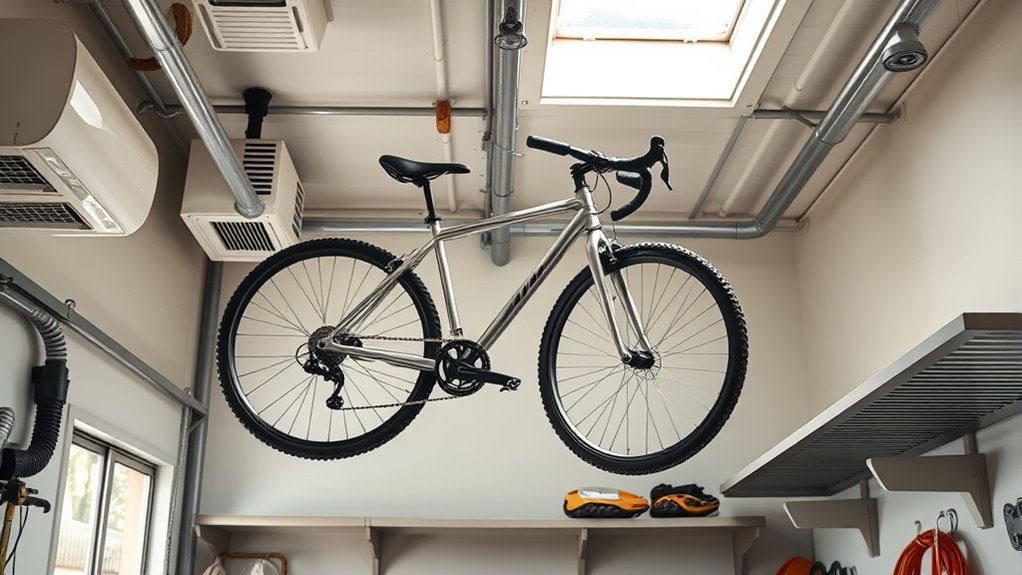
Proper ventilation is crucial for preventing moisture buildup and mold growth in your stored bike. Adequate airflow helps moisture escape, reducing the risk of rust. To achieve this, add small ventilation holes or grommets in your bike cover to promote better airflow and prevent condensation. Position your bike so air can circulate around all components, avoiding tight or enclosed storage spaces. Inside the storage area, use moisture-absorbing materials to lower humidity levels and encourage drying. Ensure proper cross-ventilation by opening windows or vents, which helps maintain consistent airflow. Regularly inspect and clean vents or air gaps to prevent dust and debris from blocking airflow and moisture escape. Good ventilation keeps your bike dry and protected from rust during storage. Additionally, understanding the importance of headphone compatibility can help you optimize your approach to maintaining and caring for your belongings. Incorporating proper storage techniques can further enhance protection against rust and corrosion over time.
Maintaining a Dry Environment Inside Storage
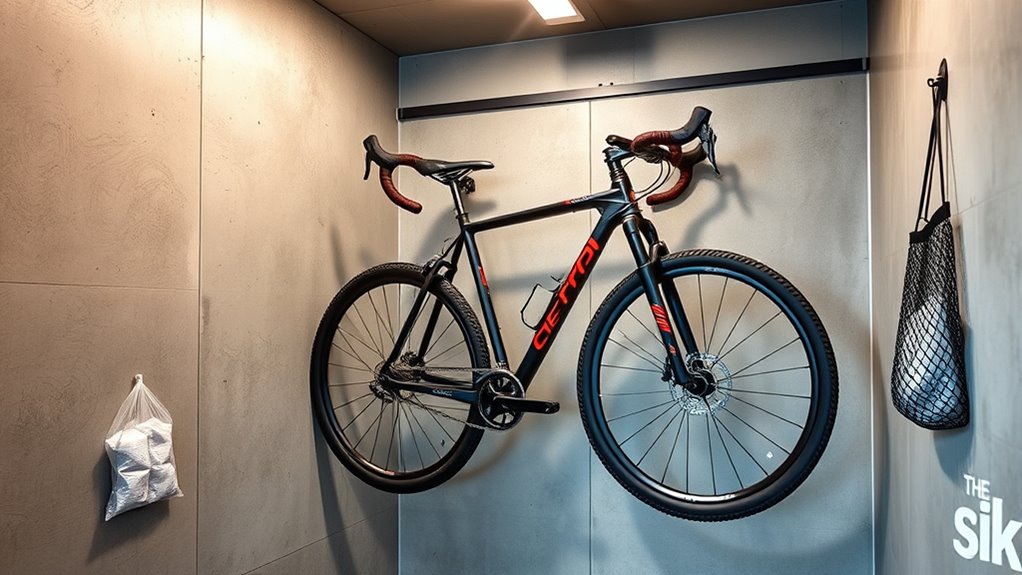
To keep your bike dry inside storage, use moisture absorbers like silica gel packets to reduce humidity. Make sure the area has proper ventilation to allow airflow and prevent condensation. Keep your storage space clean and dry, and elevate your bike off the ground to avoid contact with damp surfaces. Regularly inspecting your storage area can help identify any potential sources of moisture before they cause rust damage prevention. Ensuring good ventilation can prevent airborne pollutants from accumulating, which may contribute to corrosion. Additionally, using a paint sprayer with adjustable settings can help maintain the protective coatings on your bike, further preventing rust. Incorporating automation in business practices can also streamline maintenance routines, making it easier to keep your bike in optimal condition. For added protection, consider using best free keto diet app to track your dietary habits and support overall maintenance of your health.
Use Moisture Absorbers Effectively
Using moisture absorbers effectively is key to maintaining a dry environment inside your bike storage. Place silica gel packs or activated charcoal where they can absorb excess moisture, helping to keep humidity levels low. Regularly replace or recharge your moisture absorbers to guarantee they stay effective in controlling indoor storage humidity. Position them away from metal components to prevent concentrated moisture from causing corrosion. Monitoring humidity with a hygrometer is essential; aim to keep indoor moisture below 50% to considerably prevent rust formation. Best vacuums can assist in keeping your storage area clean and free of dust that could contribute to moisture buildup. Combine the use of absorbers with good ventilation practices for ideal results. By managing moisture levels carefully, you create an environment that minimizes rust risk and preserves your bike’s condition over time.
Ensure Proper Ventilation Flow
Ensuring good airflow inside your bike storage prevents moisture from accumulating and helps keep the environment dry. Proper ventilation is key to reducing humidity and avoiding rust. To achieve this, consider these steps:
- Install small, strategically placed ventilation holes in your storage container or cover to promote airflow.
- Position your bike so air can circulate freely around it, avoiding tight or enclosed spaces.
- Use moisture-absorbing materials like silica gel packs or desiccants to keep humidity levels low.
- Ensure adequate cross-ventilation by opening windows or vents, allowing continuous airflow.
Regularly inspect and clean ventilation openings to prevent blockages. Proper airflow ensures moisture doesn’t settle, protecting your bike from rust and prolonging its life.
Maintain Clean, Dry Storage Area
Maintaining a clean, dry storage area is essential for protecting your bike from rust and corrosion. A tidy, moisture-free space prevents rust-causing elements from settling on metal parts. Regularly inspect and clean the area to remove dust, dirt, and dampness that promote rust formation. Use moisture-absorbing materials like silica gel packs or desiccant sachets to keep humidity levels low. Ensure good ventilation to circulate air and prevent moisture buildup. Keep your bike off the ground with stands or racks to avoid contact with damp surfaces. Here’s a quick visual guide:
| Action | Purpose |
|---|---|
| Clean regularly | Remove dirt and moisture sources |
| Use silica gel packs | Absorb excess humidity |
| Keep storage dry and ventilated | Minimize moisture and condensation |
This simple approach keeps your storage dry and your bike rust-free.
Securing Your Bike Against Wind and Elements
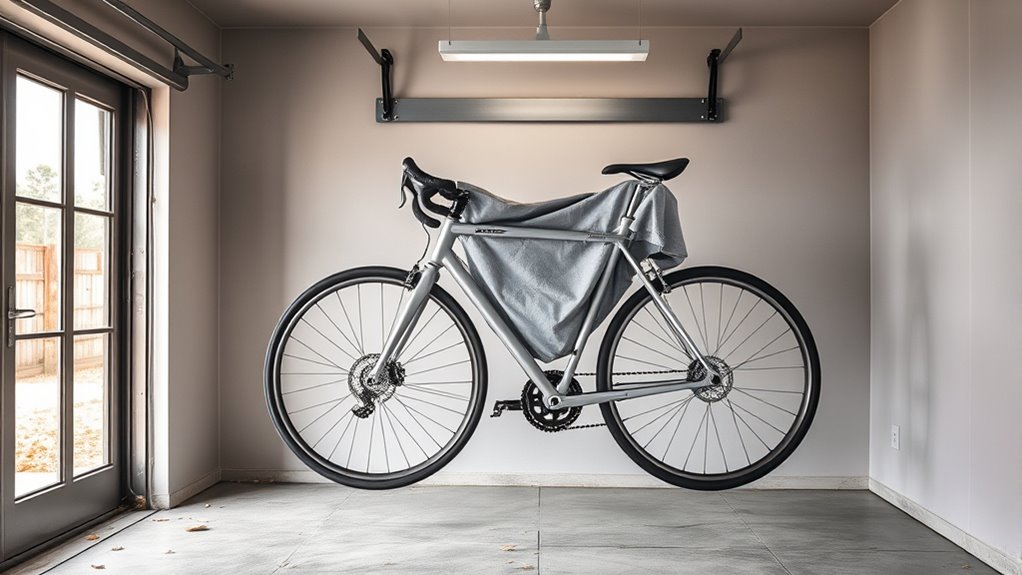
Securing your bike against wind and the elements requires a proactive approach to keep it protected. First, always use a durable cover with multiple grommets, securing it tightly at several points to prevent it from shifting. Second, ground stakes or weighted objects can help keep the cover and tarp secure, especially during gusts. Third, install tie-downs or bungee cords through reinforced grommets to anchor the bike to nearby structures or the ground, ensuring stability. Fourth, position your bike in a sheltered spot, like against a wall or under a carport, to minimize exposure to wind and moisture. Regularly check fastenings and adjust them before storms or windy days. These steps help keep your bike dry, protected, and free from rust-inducing moisture.
Applying Rust-Resistant Products and Lubricants
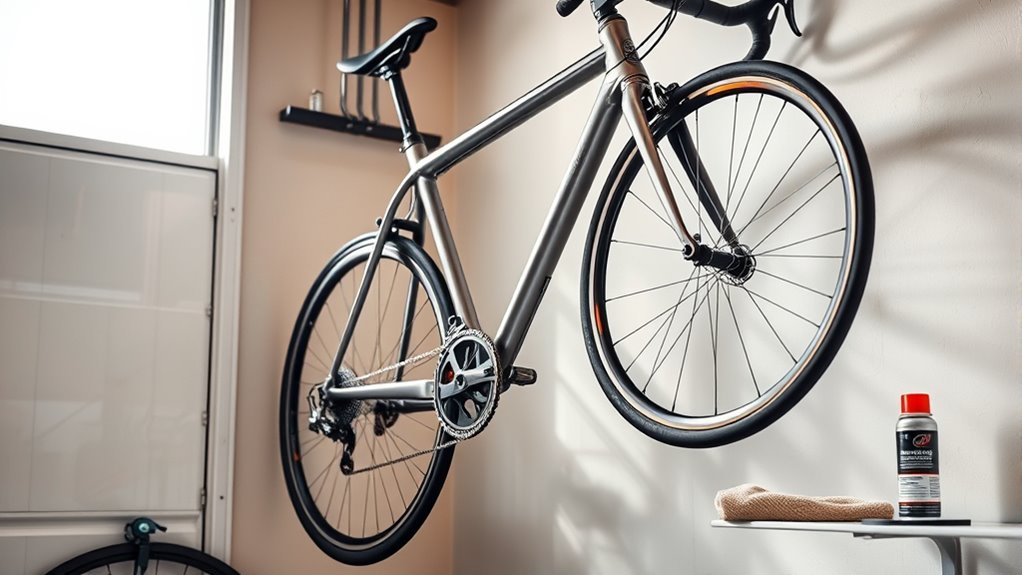
Applying rust-resistant products and lubricants is essential for protecting your bike’s metal parts from moisture and corrosion. After cleaning your bike, apply bicycle-specific wet lubricants to chains, gears, and moving parts to create a protective barrier against rust. Use rust-resistant sprays like WD-40 or dedicated anti-rust coatings on metal components such as bolts, screws, and frame joints regularly to inhibit oxidation. Don’t forget internal parts, including the bottom bracket and head tube—treat them with corrosion inhibitors or frame coatings like Framesaver to prevent internal rust. Reapply lubricants and rust preventatives periodically, especially before storage during humid or rainy seasons. Focus on high-risk areas like the drivetrain, bolts, and exposed metal surfaces to ensure maximum protection and longevity of your bike.
Regular Inspection and Maintenance Practices

Regular inspection and maintenance are crucial to keeping your bike in prime condition. By regularly checking your bike, you can catch early signs of rust and prevent rust formation before it spreads. Here are four key maintenance practices:
- Conduct visual inspections monthly to spot discoloration or flaking on metal surfaces.
- Tighten all bolts, screws, and fasteners, replacing any that show corrosion.
- Examine drainage holes and internal frames to ensure they’re free of moisture buildup.
- Inspect the chain, gears, and electrical connectors frequently, especially after riding in wet or salty conditions.
Keeping a maintenance log helps track inspections and rust treatments, ensuring ongoing protection. Implementing these practices regularly is essential for preventing rust and preserving your bike’s longevity.
Managing Environmental Factors Like Salt and Pollution
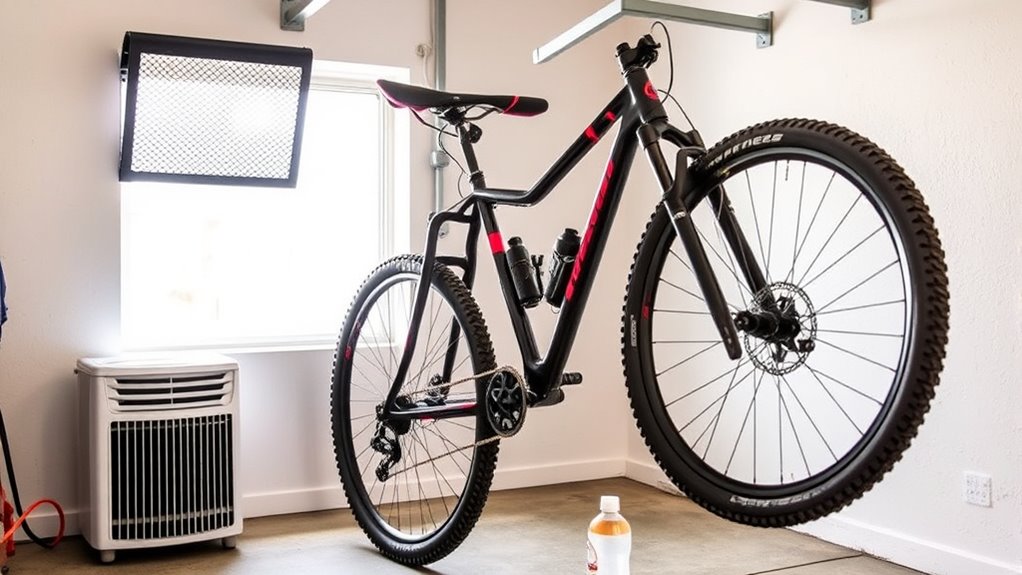
Salt from winter roads speeds up rust formation on your bike’s metal parts, especially if you don’t rinse it off promptly. Pollution introduces chemicals like sulfur compounds that worsen corrosion when combined with moisture. To protect your bike, regularly clean and apply protective coatings, especially after riding in salty or polluted environments.
Salt Exposure Risks
Exposure to salt from winter roads or coastal pollution accelerates rust formation on your bike’s metal parts. Salt exposure increases electrochemical reactions, especially inside sealed components like bearings and frames. Even small salt residues left after riding can attract moisture, leading to internal corrosion over time. To protect your bike in storage:
- Rinse thoroughly with fresh water after riding in salty conditions.
- Dry all components completely to prevent moisture buildup.
- Apply rust inhibitors to vulnerable areas.
- Store your bike in a dry, covered space away from salty air and industrial pollution.
Ignoring salt exposure risks allows moisture to seep into hidden crevices, speeding up rust formation. Proper bike storage practices are essential to safeguard your bike’s longevity and keep it rust-free.
Pollution Accelerates Corrosion
Pollution in urban environments introduces harmful chemicals like sulfur dioxide and nitrogen oxides that accelerate your bike’s corrosion. These chemical pollutants combine with moisture to form acids, leading to faster oxidation and damage. Airborne pollutants increase both internal and external corrosion, especially if your bike is left outside. Acid rain, a direct result of pollution, damages paint and metal surfaces within days, making your bike more vulnerable. To understand the impact, consider this:
| Pollutant | Effect on Bike | Resulting Damage |
|---|---|---|
| Sulfur Dioxide | Accelerates oxidation | Rust formation |
| Nitrogen Oxides | Forms acidic compounds | Corrosion of metal surfaces |
| Acid Rain | Erodes paint and metal | Structural weakening |
| Particulate Matter | Abrades surfaces | Paint chipping |
| General Pollution | Promotes internal rusting | Increased maintenance needs |
Managing environmental pollution is key to preserving your bike’s integrity.
Protective Measures Strategies
To effectively protect your bike from environmental factors like salt and pollutants, implementing strategic measures is essential. First, always use a high-quality, waterproof, and breathable bike cover to prevent moisture buildup and shield against pollutants. Second, store your bike in a dry, ventilated shed or garage to minimize contact with salt and industrial contaminants. Third, ensure proper airflow around your bike by using drainage holes, which helps prevent internal moisture and reduces rust risk. Fourth, regularly clean your bike and remove salt residues from winter roads to prevent accelerated corrosion, especially on steel alloys. Position your bike away from sprinklers, pooling water, and salty air to further diminish exposure. These steps will help you manage environmental factors and keep rust at bay.
Tips for Long-Term Outdoor Bike Storage
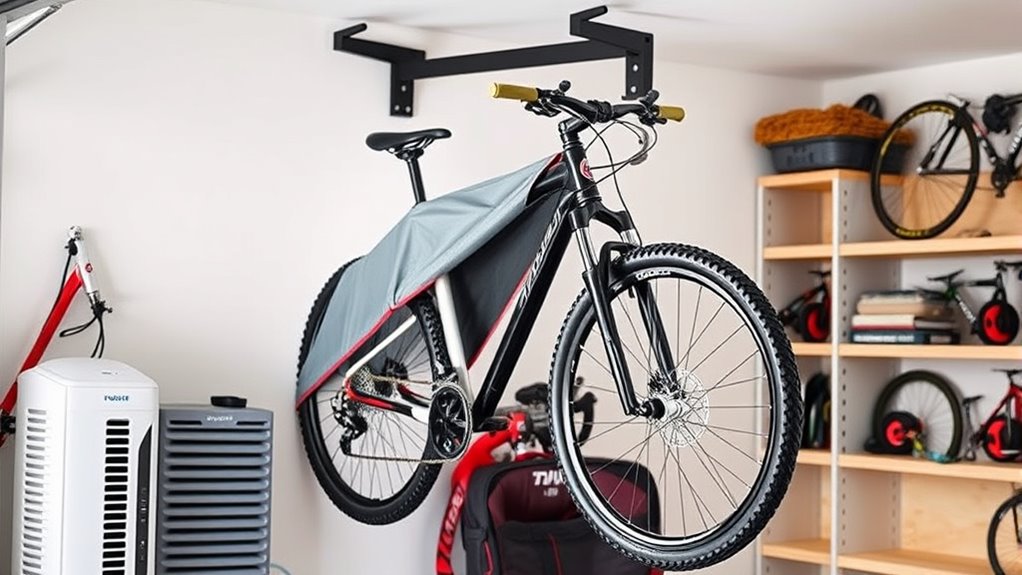
Long-term outdoor bike storage requires careful planning to protect your bike from the elements and prevent damage. Use a waterproof, breathable tarp that covers everything, including wheels and frame, to prevent rust caused by rain and moisture. Store your bike in a dry, well-ventilated shed or enclosed space with insulation to reduce condensation. Elevate the bike off the ground with stands or pallets to improve airflow and avoid direct contact with damp surfaces. Secure your bike with locks, and add bungee cords or weights to keep the cover in place during wind. Incorporate ventilation holes or grommets in the cover to promote airflow, helping to prevent rust and maintain your bike’s condition.
| Tip | Benefit |
|---|---|
| Waterproof tarp | Protects against rain and snow |
| Elevate bike | Improves airflow, prevents moisture contact |
| Secure cover | Prevents wind displacement |
| Well-ventilated space | Reduces condensation and rust risk |
| Ventilation holes | Promotes airflow to prevent rust |
Frequently Asked Questions
How to Store a Bike so It Doesn’t Rust?
To prevent your bike from rusting, store it in a dry, well-ventilated space like a shed or garage. Keep it elevated on a stand or off the ground to avoid moisture contact. Use a breathable cover that fits snugly, and make sure drain holes are clear for water to escape. Avoid plastic covers that trap humidity, and regularly check for signs of rust or moisture buildup.
What Can I Put on My Bike to Prevent Rust?
Did you know a simple spray can save your bike from rust? You can apply bike-specific corrosion inhibitors like WD-40 or FrameSaver to create a protective barrier. Also, coat exposed parts with bicycle wax or sealant to repel moisture. Greasing bolts and threads prevents internal rust, while rust-proofing sprays add extra defense. Regularly reapply these products to keep your bike rust-free and ready for the road.
Can You Store a Bike Outside Without It Rusting?
You can store your bike outside without it rusting if you take proper precautions. Keep it under a sheltered area like a shed or under an awning to avoid direct exposure to rain and snow. Use a breathable cover to protect against moisture, and regularly clean and lubricate the metal parts. Ensuring good airflow around your bike also helps prevent condensation, which can cause rust over time.
How to Prevent Rust From a Bicycle?
To prevent rust on your bike, you should clean and dry it after each ride, especially if it’s been exposed to rain or mud. Store it in a dry, well-ventilated space, or cover it with a breathable cover. Regularly apply water-displacement products like WD-40 on metal parts (avoiding brake discs and rims), and lubricate the chain and moving parts to keep rust at bay.
Conclusion
By following these tips, you can keep your bike rust-free and ready to ride whenever you want. Did you know that bikes stored improperly can develop rust in just a few weeks? That’s why regular checks and proper storage are key. With a little effort, you’ll extend your bike’s lifespan and save money on repairs. Keep your bike protected, and enjoy smooth rides for years to come!
